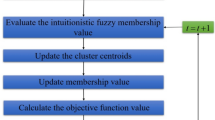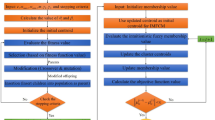Abstract
Partitional data clustering algorithms produce a relationship matrix between data and clusters, named membership matrix, which clusters can be treated as mutually exclusive (crisp) or not (fuzzy), according to data clustering approach used. Moreover, a partition obtained by a crisp algorithm can be fuzzified and so, the relationship between data and clusters be relaxed, such as in fuzzy data clustering approach. However, algorithms have your own heuristic and, iteratively, the behavior of a crisp algorithm can be different of that respective fuzzy version and, in addition, fuzzifying a crisp partition can produce different result in relation to crisp and fuzzy clustering algorithms. Therefore, this paper proposes a comparative analysis among results produced by fuzzy data clustering algorithms and their respective crisp versions and fuzzified partitions. The proposal is identify whether a fuzzy clustering algorithm can be replaced by its respective crisp with fuzzified partition, in terms of result quality. The experiments were performed to two traditional partitional algorithms and two bioinspired algorithms.
Access this chapter
Tax calculation will be finalised at checkout
Purchases are for personal use only
Similar content being viewed by others
References
Han, J., Kamber, M.: Data Mining: Concepts and techniques, 2nd edn. Elsevier, San Francisco (2006)
Rawashdeh, M., Ralescu, A.: Crisp and fuzzy cluster validity: generalized intra-inter silhouette index. In: 2012 Annual Meeting of the North American Fuzzy Information Processing Society (NAFIPS), Berkeley, pp. 1–6. IEEE (2012)
Shafeeq, A., Hareesha, K.S.: Dynamic clustering of data with modified k-means algorithm. In: International Information and Computer Networks (ICICN), Singapore, vol. 27, pp. 221–225 (2012)
Li, H., He, H., Wen, Y.: Dynamic particle swarm optimization and k-means clustering algorithm for image segmentation. Optik 126(24), 4817–4822 (2015)
de Oliveira, J.V., Pedrycz, W.: Advances in Fuzzy Clustering and Its Applications. Wiley, New York (2007)
Jain, A.K., Law, M.H.C.: Data clustering: a user’s dilemma. In: Pal, S.K., Bandyopadhyay, S., Biswas, S. (eds.) PReMI 2005. LNCS, vol. 3776, pp. 1–10. Springer, Heidelberg (2005). https://doi.org/10.1007/11590316_1
Jain, A.K.: Data clustering: 50 years beyond k-means. Pattern Recognit. Lett. 31(8), 651–666 (2010)
Carmichael, J.W., George, J.A., Julius, R.S.: Finding natural clusters. Syst. Biol. 17(2), 144–150 (1968)
Nagy, G.: State of the art in pattern recognition. Proc. IEEE 56(5), 836–863 (1968)
Ruspini, E.H., Bezdek, J.C., Keller, J.M.: Fuzzy clustering: a historical perspective. IEEE Comput. Intell. Mag. 14(1), 45–55 (2019)
Jain, A.K., Murty, M.N., Flynn, P.J.: Data clustering: a review. ACM Comput. Surv. (CSUR) 31(3), 264–323 (1999)
Ahmadyfard, A., Modares, H.: Combining PSO and k-means to enhance data clustering. In: 2008 International Symposium on Telecommunications, Tehran, pp. 688–691. IEEE (2008)
da Cruz, D.P.F., Maia, R.D., Szabo, A., de Castro, L.N.: A bee-inspired algorithm for optimal data clustering. In: IEEE Congress on Evolutionary Computation (CEC), Cancun, pp. 3140–3147. IEEE (2013)
Szabo, A., Delgado, M.R., de Castro, L.N.: A particle swarm clustering algorithm with fuzzy weighted step sizes. In: Jackowski, K., Burduk, R., Walkowiak, K., Woźniak, M., Yin, H. (eds.) IDEAL 2015. LNCS, vol. 9375, pp. 87–95. Springer, Cham (2015). https://doi.org/10.1007/978-3-319-24834-9_11
Szabo, A., de Castro, L.N., Delgado, M.R.: A constructive particle swarm algorithm for fuzzy clustering. In: Yin, H., Costa, J.A.F., Barreto, G. (eds.) IDEAL 2012. LNCS, vol. 7435, pp. 390–398. Springer, Heidelberg (2012). https://doi.org/10.1007/978-3-642-32639-4_48
Nisha, P.J.K.: A survey of clustering techniques and algorithms. In: 2015 2nd International Conference on Computing for Sustainable Global Development (INDIACom), New Delhi, pp. 304–307. IEEE (2015)
MacQueen, J.B.: Some Methods for classification and analysis of multivariate observations. In: 1967 5th Symposium on Mathematical Statistics and Probability, pp. 281–297. University of California Press (1967)
Bezdek, J.: Pattern Recognition with Fuzzy Objective Function Algorithms. Plenum Press, New York (1981)
Cox, E.: Fuzzy Modeling and Genetic Algorithms for Data Mining and Exploration. Morgan Kaufmann, San Francisco (2005)
de Castro, L.N.: Fundamentals of Natural Computing: Basic Concepts, Algorithms, and Applications. Chapman & Hall/CRC, Boca Raton (2006)
de Oliveira, J.V., Szabo, A., de Castro, L.N.: Particle swarm clustering in clustering ensembles: exploiting pruning and alignment free consensus. Appl. Soft Comput. 55, 141–153 (2017)
Rana, S., Jasola, S., Kumar, R.: A review on particle swarm optimization algorithms and their applications to data clustering. Artif. Intell. Rev. 35, 211–222 (2011)
Sengupta, S., Basak, S., Peters, R.A.: Data clustering using a hybrid of fuzzy c-means and quantum-behaved particle swarm optimization. In: 2018 IEEE 8th Annual Computing and Communication Workshop and Conference (CCWC), Las Vegas, pp. 137–142. IEEE (2018)
Kennedy, J., Eberhart, R.C.: Particle swarm optimization. In: IEEE International Conference on Neural Networks, Perth, pp. 1942–1948. IEEE (1995)
Cohen, S.C.M., de Castro, L.N.: Data clustering with particle swarms. In: 2006 IEEE International Conference on Evolutionary Computation, Vancouver, pp. 1792–1798. IEEE (2006)
Szabo, A., de Castro, L.N., Delgado, M.R.: The proposal of a fuzzy clustering algorithm based on particle swarm. In: 2011 Third World Congress on Nature and Biologically Inspired Computing, Salamanca, pp. 459–465. IEEE (2011)
Xie, X.L., Beni, G.: A validity measure for fuzzy clustering. IEEE Trans. Pattern Anal. Mach. Intell. 13(8), 841–847 (1991)
Derrac, J., Garcia, S., Molina, D., Herrera, F.: A practical tutorial on the use of nonparametric statistical tests as a methodology for comparing evolutionary and swarm intelligence algorithms. Swarm Evol. Comput. 1(1), 3–18 (2011)
Shapiro, S.S., Wilk, M.B.: An analysis of variance test for normality. Biometrika 52, 591–611 (1965)
Wilcoxon, F.: Individual comparisons by ranking methods. Biometrics Bull. 1(6), 80–83 (1945)
Acknowledgments
The authors thank Federal University of Grande Dourados (UFGD) for the financial support.
Author information
Authors and Affiliations
Corresponding author
Editor information
Editors and Affiliations
Rights and permissions
Copyright information
© 2020 Springer Nature Switzerland AG
About this paper
Cite this paper
Coradini, A., Szabo, A. (2020). A Comparative Analysis Between Crisp and Fuzzy Data Clustering Approaches for Traditional and Bioinspired Algorithms. In: Analide, C., Novais, P., Camacho, D., Yin, H. (eds) Intelligent Data Engineering and Automated Learning – IDEAL 2020. IDEAL 2020. Lecture Notes in Computer Science(), vol 12490. Springer, Cham. https://doi.org/10.1007/978-3-030-62365-4_29
Download citation
DOI: https://doi.org/10.1007/978-3-030-62365-4_29
Published:
Publisher Name: Springer, Cham
Print ISBN: 978-3-030-62364-7
Online ISBN: 978-3-030-62365-4
eBook Packages: Computer ScienceComputer Science (R0)




